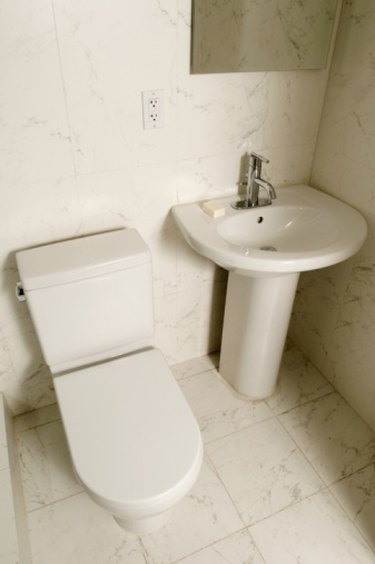Things You'll Need
Electric drill
Hammer
Screwdriver
Electric saw
Tarp or canvas
Masking tape
Tape measure
Utility knife
Gloves
Goggles
Breathing mask
Tile, ceiling covering or other matching item

Closets are usually small compartments within a home used for storage and nothing else. Depending on the size they may only be large enough for a person to step into, or large enough to be considered another room. Taking out a closet, especially a larger one, can add space to a bedroom or bathroom when the area is needed more than the storage. The procedure for taking out a closet to expand a bathroom, as well as its benefit, varies from design to design, and whether or not a wall needs to be removed.
Step 1
Determine how much of a difference the closet will make in usable space. If it is a small compartment not much wider than the door, it may be best to simply use the space as a closet without a door. However, bigger closets, such as walk-ins, can add a great deal of space by removing any division between the bathroom and the closet.
Video of the Day
Step 2
Prepare the area. Since removing the closet may lead to sawing, hammering or other such activities that create debris, make sure that any items that may be affected by the work are removed. This includes anything in the closet. Cover fixtures with a tarp, canvas or other disposable surface.
Step 3
Remove the door if one is present. Locate the screws within the door hinges and use the screwdriver to remove them. Usually hinges are located near the top and bottom of the door, with the possibility of one in the middle, with up to eight screws per hinge. Depending on whether or not the door that will be used is larger, it may only be necessary to unscrew the side of the hinge that attaches to the door frame. Once the hinges are detached remove the door. If necessary, use the screwdriver to remove the strike plate on the opposite door frame where the handle bolt is secured.
Step 4
Determine the load of the wall, if there is one, between the closet and the bathroom. The primary issue is whether or not the closet wall is load bearing -- one that helps carry the weight of the roof. There is no definitive rule for determining whether a wall is load bearing -- it is entirely dependent on the architectural design of the house. Consider the location of the walls and ceiling, the amount of space between the walls and any other support structure and the slope of the ceiling. If possible, consult the floor plan of the house or an expert (an architect, carpenter, builder or other professional). If it is determined that the wall is load bearing, do not remove it as it could lead to the ceiling or upper floors collapsing.
Step 5
Determine if there is any electrical wiring in the wall. If there is a light switch or electrical outlet on the wall it means wires are present. If there is any electrical wiring present, consult an electrician to reroute the wires before removing the wall. There may also be wiring routing through the wall found later. This can also be moved by a trained electrician. If necessary, turn off the power to the switch or outlet at the electrical circuit box.
Step 6
Mark off the extent of the wall to be removed. Use a tape measure to outline the hole to be made and tape it off. Use a utility knife to score a line where the hole is to end.
Step 7
Remove the drywall covering on both sides. Exact procedure depends on the material that covers the wall, but normally this should be done by using a utilty knife to cut the drywall away from where the wall meets the ceiling and moving downward. Wear goggles and a breathing mask if necessary, as this will be a dusty job.
Step 8
Remove the wall covering. Use a hammer to punch a hole through the covering and pull as much away as possible. Wear gloves, goggles and a breathing mask while doing this. Be sure to clear the removed wall covering from the area and don't expect to be able to reuse it. Once the wall covering is gone check again for any electrical wiring or plumbing (there likely won't be any plumbing in a wall between a bathroom and closet, but check just in case). Consult an electrician or plumber if necessary.
Step 9
Remove the studs by either using a heavy hammer to knock the studs off the bottom plate, twisting them loose from the top or sawing through the middle and twisting out both ends separately. Remove the top and bottom wall plates using the same tools as necessary. There should now be a clear passage between the bathroom and the closet.
Step 10
Touch up the edges where the wall has been removed with paint or the same covering as the floor or ceiling to match the newly extended bathroom. Typically this type of closet removal is used for storage, seating, a makeup nook or other functions that won't require plumbing.
Video of the Day